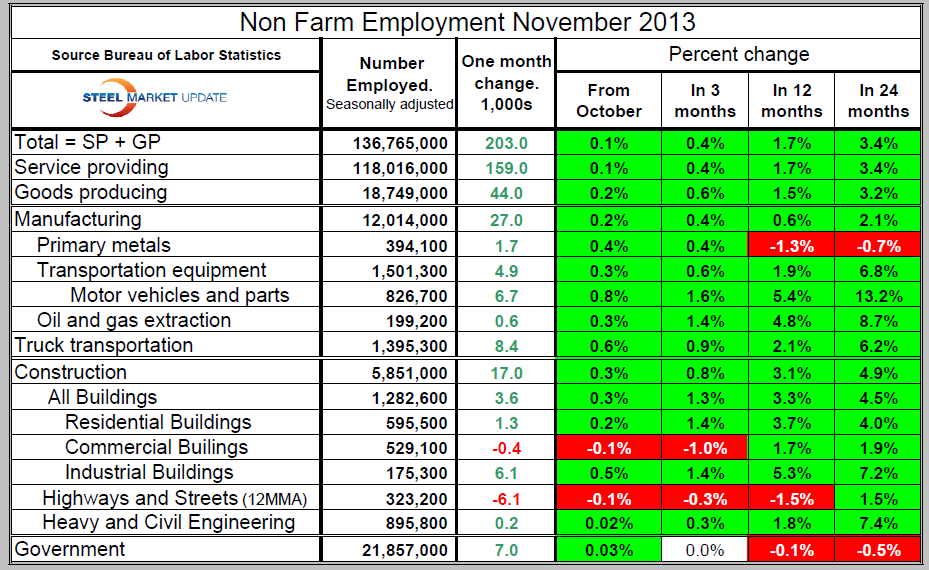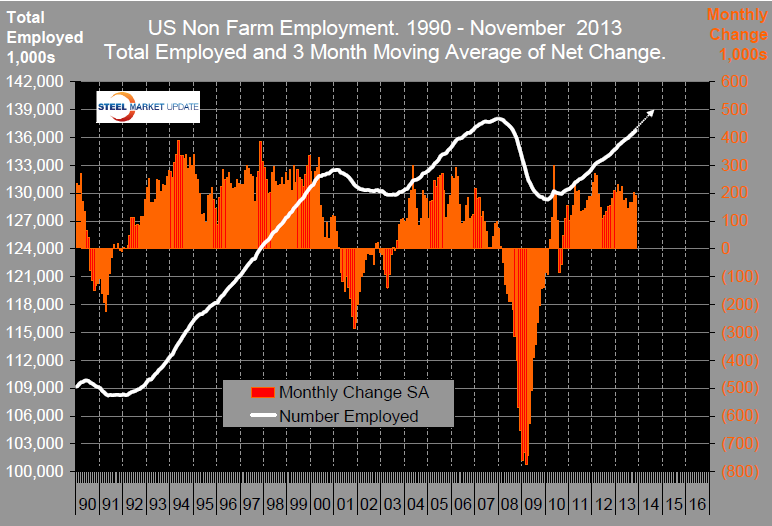Economy

Net Job Creation Has Best Goods Producing Result Since February
Written by Peter Wright
December 8, 2013
Net job creation in November 2013 was 203,000 of which 159,000 were service providing and 44,000 were goods producing. This was the best goods producing result since February this year. Since February 2010, manufacturing has added 554,000 jobs and construction 329,000. In November the private sector added 196,000 jobs and government added 7,000. Of the goods producing, 27,000 were in manufacturing and 17,000 in construction (Table 1).
This was the best performance for manufacturing industries in 20 months. Other points of interest from the November numbers are that primary metals added jobs in three of the last four months, motor vehicle manufacturing has added jobs for seven straight months except for the July maintenance shutdowns and trucking has been up for five straight months.
On a rolling 12 month basis, part time employees with <35 hours per week have declined by almost one million. Since February 2010 which was the employment low point following the recession, the private sector has added 8,058,000 jobs and government has shed 613,000. Total employment is still on track to reach the pre-recession high by the third quarter of next year (Figure 1). It is evident from long term graphical analysis that this employment recovery is now looking a lot like the 2004 through 2006 period which is good news because job recovery has been slowing after each recession since 1940.
Reuters reported on the November result as follows; “U.S. employers hired more workers than expected in November and the jobless rate fell to a five-year low of 7.0 percent, heightening expectations the Federal Reserve will soon start ratcheting back its bond-buying stimulus. Nonfarm payrolls increased by 203,000 new jobs last month, the Labor Department said on Friday. The unemployment rate dropped three tenths of a percentage point to its lowest level since November 2008 as some federal employees who were counted as jobless in October returned to work after a 16-day partial shutdown of the government. Job gains for September and October were revised to show 8,000 more jobs created than previously reported, lending more strength to the report. Other details were also upbeat, with employment gains across the board, average hourly earnings rising and the workweek lengthening. The U.S. labor market is still far from healed, but it certainly is moving in the right direction,” said Eric Stein, co-director of the Global Income Group at Eaton Vance Investment Managers in Boston.
U.S. stocks bounced higher at the open, the dollar rose against the euro and the yen, and U.S. benchmark Treasury yields hit a three-month high as traders increased bets the Fed could reduce its bond purchases as early as its next meeting on December 17-18. The central bank has been buying $85 billion in Treasury and mortgage-backed bonds each month to hold long-term borrowing costs down in a bid to spur a stronger economic recovery. Despite the jobs data, many economists said the central bank was still likely to hold off reducing its purchases until January or March to ensure the economy was on solid ground. “This number puts a December taper on the table, but it isn’t a certainty,” said Stein.
Economic data so far for the fourth quarter have been mixed, with labor market and consumer spending indicators firming. However, the housing market and business spending have slowed. Economists believe the Fed will probably not want to pull back on its stimulus before lawmakers on Capitol Hill strike a deal to fund the government. That could come as soon as next week, however. Congressional aides have said negotiators were down to the final details as they tried to close in on a deal.
A separate report from the Commerce Department showed consumer prices were steady in October, after having risen by 0.1 percent for three straight months. Over the past 12 months, prices rose 0.7 percent, the smallest gain since October 2009. Excluding food and energy, prices were up just 0.1 percent for a fourth straight month. These so-called core prices were up only 1.1 percent from a year ago. Both inflation measures remained well below the Fed’s 2 percent target, and some economists said they provided another reason for the central bank to move cautiously in pulling back its stimulus.”

Peter Wright
Read more from Peter WrightLatest in Economy

Steel groups welcome passage of budget bill
Steel trade groups praised the passage of the Big Beautiful Bill (BBB) in Congress on Thursday.

Industry groups praise Senate for passing tax and budget bill
The Steel Manufacturers Association and the American Iron and Steel Institute applauded the tax provisions included in the Senate's tax and budget reconciliation bill.

Chicago PMI dips 0.1 points in June
The Chicago Purchasing Managers Index (PMI) slipped 0.1 points to 40.4 points, in June.

Multi-family pullback drives housing starts to 5-year low in May
US housing starts tumbled in May to a five-year low, according to figures recently released by the US Census Bureau.

Architecture firms still struggling, ABI data shows
Architecture firms reported a modest improvement in billings through May, yet business conditions remained soft, according to the latest Architecture Billings Index (ABI) release from the American Institute of Architects (AIA) and Deltek.


